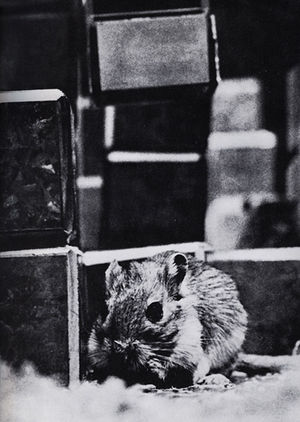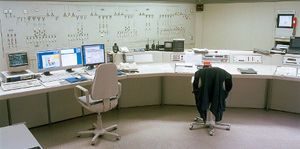Dave Young - Project Survey
SEEK, also known as BLOCKSWORLD - Nicolas Negroponte and the Architecture Machine Group
- "Seek" 1970 Nicholas Negroponte with Architecture Group Machine M.I.T. Originally shown at the "Software" exhibition, Curated by Jack Burnham for the Jewish Museum in New York 1970. This piece consisted of a Plexiglass environment full of small blocks and inhabited by gerbils, who continuously changed the position of the blocks. Following instructions programmed buy the authors the robotic arm automatically rearranged the blocks in a specific pattern.
- source: http://norgacs1projectone.blogspot.nl/2009/02/seek.html
The piece creates a 'closed system' - an entropic environment that is dismantled through the movements of the gerbils who inhabit it. It is a feedback loop: the gerbils knock down the blocks, and the robotic arm repairs the structure to some ideal pre-programmed by the Architecture Machine Group (AMG). To paraphrase [EcologyOfMind Gregory Bateson], animals are the only really unpredictable things in the world - the creation of a system that can rationalise this unpredictability is an attempt to ward off entropy, the state of immutable decay in the environment. The story goes that the society of Blocksworld did in fact descend into gerbil-cannibalism, proving once again that entropy prevails despite our best efforts to halt it.
The above source (although idiosyncratically translated from german to english) seems to state that the Architecture Machine Group at MIT were part of the "Laboratory of Urban Systems". I am curious to find out some other experiments made by this lab, I'll post them on this page if relevant.
Sources
- Curious imagery of gerbils and cubes => http://www.cyberneticians.com/slideshow/seek1.html
- Cybernetic Zoo article on SEEK with plenty of images of the AMG = > http://cyberneticzoo.com/?p=3794
- Another article about SEEK => http://www.projektklasse.de/html/personen/lehrende.html
At the Control Room - Patrick Raddatz
- According to a legend, the then newly elected president of the USA, Ronald Reagan, asked upon introduction to the White House: ‘Where is the War Room?’. At The Control Room is a visual study of work environments like Control and Observation Room, in which complex and integrated work processes are reduced to a few cues and movements and furthermore, in which work takes place on a highly abstract level. These work environments first appeaed in the heydays of industrialisation, their complexion always directly reflecting the positions of the workers and their superiors, the technological evolution and it’s contemporary formal principles. The photographs are showing rooms from different domains, they are not only showing the technological state of the art they allow for conclusions of the then valid aesthetical, corporative and social relation of mankind to it’s technology from the perspective of the industry and the workers.
- source: http://ion.li/projekte-projects/at-the-control-room
This photoseries is more related to a project from last year about fictional computer interfaces, but still bears some relevance to my current interests. The rooms are designed according to the logic of the systems they control. Architecture, which we can understand as a discipline interested in positioning people in space, converges with the systems ideology in these images, creating a dialog of control between the environment and the computer systems which inhabit it.


